Technik Museum Speyer, Germany (2005)
 Photos © Ruud Leeuw
Photos © Ruud LeeuwDate of visit: 01Aug05.
 Photos © Ruud Leeuw
Photos © Ruud Leeuw
 The Lufthansa Boeing 747 sits high (very high!), overlooking the entire museum. Hard to miss... This is Boeing 747-230BM D-ABYM (cn 21588/342). It was transferred to the museum in March 2002. |
 |

|
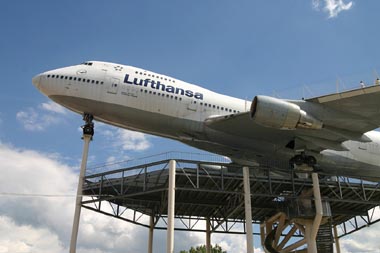 Another shot of the 747, Mother of All Airliners!
Another shot of the 747, Mother of All Airliners!
|
 This is of course the actual entrance.
This is of course the actual entrance.Keep your stub if you intend to visit the museums both at Speyer as well as at Sinsheim: it will get you a discount. This is Nord N2501 Noratlas no.154 (c/n 154). In the late 1940s, design was started to replace the Douglas C-47s and Junkers Ju-52s then in French service. The "Nord 2500", with the twin-boom arrangement resembled the American Fairchild C-82 Packet. The N-2500 was powered by 2 SNECMA-built Gnome-Rhone 14R radial engines with 1,195 kW (1,600 HP) each. First flight was on 10Sep49. It was decided to power the 2nd prototype with English Bristol Hercules type 739 engines, developing 2,040 hp on takeoff, to which Rotol four blade props were fitted. From then on it was designated Nord 2501. This prototype crashed on 06July52 at Lyon-Bron, killing all 5 people aboard, including famous female aviator Maryse Bastié. The first orders for the N2501 was placed on 10July51 and the 1st production aircraft flew on 24Nov52. Not until early 1953 was the plane dubbed Noratlas. The French Air Force (the Armee de l'Air-AdA), ordered 3 pre-production examples of the type; the first flew on 10Sep52. The AdA ordered for an initial production batch of 40 N2501s; the AdA ordered a total of 200 N-2501s. The Noratlas had a flightcrew of 4 or 5; it could carry 45 troops or 31 paratroops with drop gear or 18 stretchers with medical attendants or 6,800 kilograms (14,900 pounds) of cargo. The AdA N2501s saw combat service in Algeria and during the Suez conflict (1956). A few soldiered on in AdA service into the 1970s. MORE... and EVEN MORE.... |
 VFW-Fokker VFW-614 OY-TOR (cn 4) Cimber Air.
VFW-Fokker VFW-614 OY-TOR (cn 4) Cimber Air.
The VFW 614 was the first passenger jet to go into large-scale production in the Western part of Germany. Developmental work started in 1963, as a co-operative project under the leadership of the Vereinigte Flugtechnische Werke - Fokker GmbH with participation of further enterprises such as MBB, Sabca (Belgium) and Fairey (UK). |
 Whilst the Boeing 747 has written the history for mass air transport, the Douglas DC-3 wrote the history of commercial air transport.
Whilst the Boeing 747 has written the history for mass air transport, the Douglas DC-3 wrote the history of commercial air transport.F-BFGX (cn 11722) is seen here in Air Inter colourscheme.
This Douglas C-53 vintage transport was delivered to the USAAF on 29May43 with tailnumber 42-68795. It was transferred to the Reconstruction Finance Corporation (RFC) in 1945. |
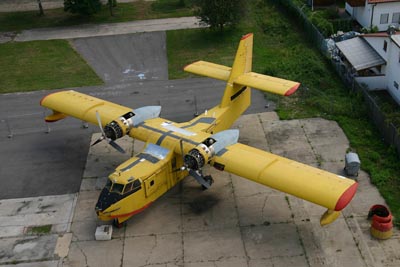 Canadair CL-215-1A10 F-ZBAR (cn 1021) Ex Securite Civile; it is a recent addition to this museum, having moved here in Feb.2005.
Canadair CL-215-1A10 F-ZBAR (cn 1021) Ex Securite Civile; it is a recent addition to this museum, having moved here in Feb.2005.
|
 Antonov An-2TP RA-41343 (cn 1G65-18). Versatile single-engine biplane utility transport. Driven by one 1000 hp. Shvetsov Ash-62IR radial engine. First flew in 1947.
Antonov An-2TP RA-41343 (cn 1G65-18). Versatile single-engine biplane utility transport. Driven by one 1000 hp. Shvetsov Ash-62IR radial engine. First flew in 1947.This biplane transport has been used since 1947 with great succes and in many countries: looks can be deceiving! Over 18000 may have been built! It served and serves in many roles: for training, as firefighting aircraft, as agricultural aircraft, and in many other roles. The An-2 has also been built as floatplane (An-4); the normal wheeled landing gear can easily be interchanged with skis. For agricultural purposes a turboprop-engined version, the An-3 (SKh, "Selsko-Khosiajstwennij" = "Agricultural"), was created recently. The prototype of the An-2, designed to a specification of the Ministry of Agriculture and Forestry of the USSR, made its first flight on 31Aug47. In 1948 the aircraft went into production in the USSR as the An-2, with a 746 kW (1000 hp) ASh-62 engine. By 1960, more than 5000 An-2s had been built in the Soviet Union. Licence rights were granted to China, where the first locally produced An-2 was completed in December 1957, as the Yunshuji-5 or Y-5. Since 1960, apart from a few dozen Soviet built An-2Ms, continued production of the An-2 has been primarily the responsibility of PZL Mielec, the original licence arrangement providing for two basic versions: the An-2T transport and An-2R agricultural version. The first Polish built An-2 was flown on 23Oct60. Mielec has since built more than 11950 An-2s for domestic use and for export to the USSR (10427), Bulgaria, Czechoslovakia, Egypt, France, the then German Democratic Republic, Hungary, Iraq, North Korea, Mongolia, Netherlands, Nicaragua, Romania, Sudan, Tunisia, Turkey, the UK, Venezuela and Yugoslavia. www.aviation.ru/An/ |
 This Antonov An-26S Curl is ex/ 52+04 (LSK 375) and has c/n 10409.
This Antonov An-26S Curl is ex/ 52+04 (LSK 375) and has c/n 10409.
|
 "Flying" alongside the An-26 is:
"Flying" alongside the An-26 is:Dassault Mercure 100 F-BTTB (cn 2). The French answer to the Boeing 737, but not as successful.... It is preserved here in the Air Inter colours. Expecting massive sales in the 140-seats segment or the ailriners market, Dassault created 4 factories: Martignas, Poitiers, Seclin and Istres. On 10Jan72, Air Inter ordered 10 aircraft for delivery between 30Oct973 and 13Dec75. But after Air Inter's order for 10, the phone stopped ringing... The assembly line was on 15Dec75. Only the 2 prototypes and the 10 Air Inter planes will have been produced. http://caea.free.fr/en/coll/mercure.html |
 Antonov An-22 UR-64460 (cn 0103).
Antonov An-22 UR-64460 (cn 0103).
This dinosaur of an aircraft is the largest turboprop powered aircraft ever built. In comparison: it has a maximum takeoff weight equal to that of the Airbus A340-300! |
 It was flown to this museum in December 1999.
It was flown to this museum in December 1999.
Some notable features of the An-22 include the comprehensive navigation and precision drop avionics complete with three separate radars, a 14-wheel undercarriage (tire pressures can be adjusted from the flightdeck to optimize the aircraft for different airfield surfaces), a reinforced titanium floor with integral rear loading ramp, four overhead gantries and two floor winches for freight handling, twin tails, and double slotted wing flaps. Also, like the An-12, the main cargo hold is not pressurized, troops/passengers are carried in a forward cabin which accommodates 29. |
 An-22 Antey. A front view of this 4-engined heavy (HEAVY!) military and commercial freighter. Four 15,000 shp Kuznetsov NK-12MA turboprops. The twin tailfins of 'Antej' (Anteus) are an uncommon characteristic. It was the largest aircraft in the world until the introduction of the C-5.
An-22 Antey. A front view of this 4-engined heavy (HEAVY!) military and commercial freighter. Four 15,000 shp Kuznetsov NK-12MA turboprops. The twin tailfins of 'Antej' (Anteus) are an uncommon characteristic. It was the largest aircraft in the world until the introduction of the C-5. The first one was built in Kiev 18Aug64 and first flown 27Feb65. Production ran from Nov65 to Jan76 in Tashkent. 44 An-22 + 22 An-22A were built. Source: www.aviation.ru/An/ |
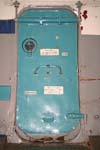
|

|
 A closer look at the gigantic cargodoor. |
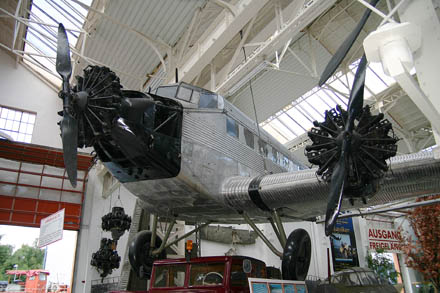 Junckers Ju-52 CA-JY. Florian Sindermann on Airliners.net: "This Ju-52 had an eventful past before it found its retirement in the Technikmuseum Speyer. In 1940 it brought a load of supplies for German troops to Norway and had to land on a frozen lake. There was not enough fuel for a flight back to Germany, so it remained on the lake, was attacked by British and Norwegian Air Force and finally sunk into the lake in spring when the ice melted. There it spent 46 years lying 75 meters below the water surface until it was salvaged in 1986."
Junckers Ju-52 CA-JY. Florian Sindermann on Airliners.net: "This Ju-52 had an eventful past before it found its retirement in the Technikmuseum Speyer. In 1940 it brought a load of supplies for German troops to Norway and had to land on a frozen lake. There was not enough fuel for a flight back to Germany, so it remained on the lake, was attacked by British and Norwegian Air Force and finally sunk into the lake in spring when the ice melted. There it spent 46 years lying 75 meters below the water surface until it was salvaged in 1986."
|
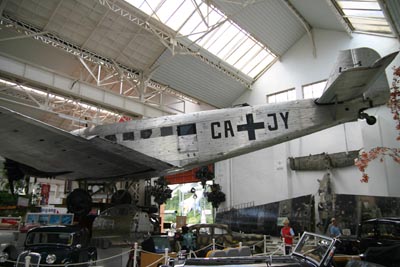
|
|
Dornier Do-24T3 2663. Recovered from lake Muritz. The webpage www.dornier24.com/pages/preservedSpeyer.html has a fascinating account: "Coming from Rettung Zwischen den Fronten the following: The Do-24 Werk Nr. 97 had been used in the so called "Aktion 24". During this operation, beginning April 1945, four Do-24 had been ordered to the "Erprobungsstelle der Luftwaffe in Rechlin" in which they were prepared for "Kamikaze" operation against four railway-bridge over the river Weichsel in Thorn, Warschau, Deblin and Dunjawec (east of Krakow) to stop the supply line of the Soviets.  The Do-24 had been chosen to do this job, because the flyingboat was able to carry such a big aoumt of explosives. Each Do-24 should had been flown by it normal pilot to a point not far away from its target. At this point the normal pilots are supposed to leave the flying boat in a small rubber dingy trying to reach the bank of the "Weichsel". There the SO-Pilots (Selbstopfer) pilots should steer the Do24 directly against of the bridge piers. The following explosion of the "explosive Do24-Kamikaze" should finally collapse the brigde. But before the so called "Aktion 24" could start, an air raid of the B-24 on the area ot the airfields of Rechlin and it surroundings, destroyed three of the four "Sprengstoff Do-24´s". "
The Do-24 had been chosen to do this job, because the flyingboat was able to carry such a big aoumt of explosives. Each Do-24 should had been flown by it normal pilot to a point not far away from its target. At this point the normal pilots are supposed to leave the flying boat in a small rubber dingy trying to reach the bank of the "Weichsel". There the SO-Pilots (Selbstopfer) pilots should steer the Do24 directly against of the bridge piers. The following explosion of the "explosive Do24-Kamikaze" should finally collapse the brigde. But before the so called "Aktion 24" could start, an air raid of the B-24 on the area ot the airfields of Rechlin and it surroundings, destroyed three of the four "Sprengstoff Do-24´s". "
|

|

|

|

|

|

|

|

|

|

|

|

|

|

|

|

|

|

|

|

|
The
|
Sources and External Links:
Technik Museum Speyer
Speyer at www.paulnann.com
Wolfgang Bredow at Speyer
http://home2.scarlet.be/asaanr/MusSpeyer.htm
Do-24 survivors in musea & private collections
Airliners of the 1970s
|
|
Last updated 8.10.2005